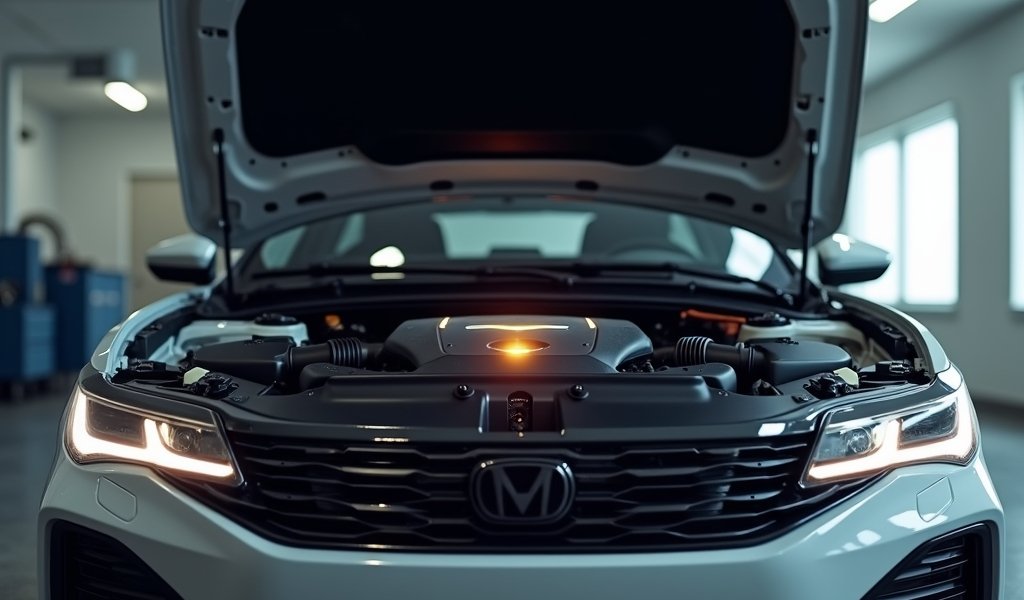Overview
This article explains that oxygen sensors typically need replacement every 60,000-100,000 miles depending on vehicle age and driving conditions, with symptoms of failure including reduced fuel economy, rough idling, and check engine lights. It covers DIY versus professional replacement options, strategies to extend sensor life through proper maintenance, cost considerations, and emerging sensor technologies, emphasizing that timely replacement saves money by preventing efficiency losses and potential catalytic converter damage.
Table of Contents
- Understanding Oxygen Sensors: The Silent Heroes of Your Engine
- 5 Telltale Signs Your Oxygen Sensors Need Attention
- The Smart Guide to Optimal Oxygen Sensor Replacement Intervals
- DIY vs. Professional Replacement: What’s Right for You?
- 7 Proven Hacks to Extend Your Oxygen Sensor’s Lifespan
- Money-Saving Strategies for Oxygen Sensor Maintenance
- The Future of Oxygen Sensors: What’s Coming Next
- Conclusion
- Frequently Asked Questions
Understanding Oxygen Sensors: The Silent Heroes of Your Engine
When it comes to your vehicle’s performance and efficiency, oxygen sensors play a crucial role that often goes unnoticed until something goes wrong. These small but mighty components monitor the oxygen levels in your exhaust gases, helping your engine’s computer make real-time adjustments to the air-fuel mixture. The oxygen sensor replacement interval is a topic that deserves more attention than it typically receives, as proper timing can save you money and prevent bigger problems down the road.
Located in your exhaust system, oxygen sensors (also called O2 sensors) are essentially the communication bridge between your engine and its computer system. They constantly measure oxygen content in the exhaust and send signals to adjust fuel delivery for optimal combustion. This delicate balance affects everything from fuel economy to emissions levels and overall engine performance.
Modern vehicles typically have between two and four oxygen sensors. You’ll find upstream sensors (before the catalytic converter) and downstream sensors (after the converter). Each serves a specific purpose in your vehicle’s emissions and fuel management systems. If you’re experiencing poor fuel efficiency or emissions issues, check engine light problems might be related to your oxygen sensors.
As a mechanic with over 15 years of experience, I’ve seen countless vehicles suffer from problems that could have been avoided with timely oxygen sensor replacement. Understanding when and why to replace these components can make a significant difference in your vehicle’s longevity. Need personalized advice about your specific vehicle? Don’t hesitate to contact our team of certified technicians for tailored guidance.
5 Telltale Signs Your Oxygen Sensors Need Attention
Before we dive into replacement intervals, it’s important to recognize the warning signs that your oxygen sensors might be failing. Your vehicle has ways of telling you when these critical components aren’t functioning properly.

The most obvious indicator is the check engine light illuminating on your dashboard. This warning shouldn’t be ignored, as oxygen sensor issues represent one of the most common reasons for check engine lights to activate. When this happens, a diagnostic scan typically reveals codes related to oxygen sensor performance.
Beyond the warning light, here are specific symptoms to watch for:
- Noticeably reduced fuel economy (often dropping by 10-15%)
- Rough idling or hesitation during acceleration
- Failed emissions tests due to higher hydrocarbon output
- Black exhaust smoke or a strong sulfur odor
- Overall decrease in engine performance and responsiveness
These symptoms don’t always appear all at once. In fact, declining oxygen sensor performance can be gradual, making it easy to miss the signs until they become more severe. This is why following a proper car maintenance schedule that includes oxygen sensor inspection is crucial.
I recently worked with a customer who complained about poor acceleration and reduced gas mileage. After diagnosing his vehicle, we discovered two failing oxygen sensors that had slowly degraded over time. After replacement, his vehicle’s performance improved dramatically, and his fuel economy increased by nearly 20%. If you’re experiencing any of these symptoms, contact us for a comprehensive diagnostic evaluation.
The Smart Guide to Optimal Oxygen Sensor Replacement Intervals
Now, let’s address the million-dollar question: when exactly should you replace your oxygen sensors? The truth is, there’s no one-size-fits-all answer, but there are reliable guidelines based on vehicle type, driving conditions, and sensor technology.
For most modern vehicles (those manufactured after 2000), oxygen sensors typically last between 60,000 and 100,000 miles. However, this range can vary significantly based on several factors. Vehicles with older technology generally need more frequent replacements, while newer models equipped with advanced materials may extend beyond the 100,000-mile mark.
Here’s a breakdown of typical replacement intervals by vehicle age:
- Pre-1996 vehicles: Every 30,000-50,000 miles
- 1996-2004 vehicles: Every 60,000-80,000 miles
- 2004 and newer vehicles: Every 80,000-100,000 miles
- Latest models with advanced sensor technology: Up to 150,000 miles
It’s worth noting that these are general recommendations. Your specific vehicle’s owner manual should always be your primary reference for maintenance schedules. Many manufacturers include oxygen sensor replacement as part of their recommended service intervals, which might differ slightly from these guidelines.
Driving conditions also play a significant role in sensor longevity. If you frequently drive in stop-and-go traffic, take many short trips, or live in areas with extreme temperatures, your oxygen sensors may wear out faster. Similarly, vehicles that run on lower-quality fuel or those with oil consumption issues often experience shortened sensor life spans.
For the most accurate assessment of your vehicle’s oxygen sensor condition, consider having them tested during routine maintenance around the 60,000-mile mark. Our diagnostic equipment can measure sensor response time, which is a reliable indicator of remaining useful life. Contact our service department to schedule this important check-up and potentially save yourself from more costly repairs down the road.
DIY vs. Professional Replacement: What’s Right for You?
When your oxygen sensors need replacing, you face a choice: tackle the job yourself or seek professional assistance. As someone who’s guided countless DIY enthusiasts through this process, I can offer perspective on both approaches.
For the mechanically inclined, oxygen sensor replacement can be a manageable DIY project. The basic process involves locating the sensors (usually along the exhaust manifold and downstream near the catalytic converter), disconnecting the electrical connections, and unscrewing the old sensors before installing new ones. Special oxygen sensor sockets make the job easier, and most replacements require minimal additional tools.
However, there are important considerations before taking the DIY route:
- Sensor accessibility varies greatly by vehicle model
- Seized or corroded sensors can be extremely difficult to remove
- Proper torque specifications must be followed during installation
- Some vehicles require reprogramming or system resets after replacement
- Using the exact OEM-specified sensor is critical for proper function
Professional replacement offers several advantages, particularly for those less comfortable with automotive repairs. Technicians have specialized tools, access to manufacturer-specific parts, and diagnostic equipment to verify proper function after installation. A professional can typically complete the job in 1-2 hours, whereas a DIY approach might take significantly longer for first-timers.
Cost-wise, DIY replacement can save on labor charges, which typically range from $80-150 depending on your location and vehicle type. However, this saving must be weighed against potential complications and the value of your time. According to AAA’s repair cost estimates, professional oxygen sensor replacement generally costs between $200-$300 total, including parts and labor.
Whether you choose DIY or professional service, using quality parts is non-negotiable. Inferior sensors can fail prematurely or cause performance issues. If you’re unsure which route is best for your specific situation, contact our service advisors for personalized guidance on your oxygen sensor replacement options.
7 Proven Hacks to Extend Your Oxygen Sensor’s Lifespan
While replacement is inevitable, there are several practical ways to maximize your oxygen sensor’s service life and potentially extend the replacement interval. These strategies not only save you money but also contribute to better overall vehicle performance.

Here are seven effective approaches I’ve recommended to customers over the years:
- Use high-quality fuel: Premium fuels generally contain fewer contaminants that can damage sensors. While you don’t need premium all the time, using it occasionally can help clean your system.
- Maintain your engine properly: Regular oil changes prevent oil contamination in the exhaust system, which can coat sensors and reduce their effectiveness.
- Address engine misfires promptly: Misfires can cause unburned fuel to reach the sensors, leading to contamination and premature failure.
- Keep your fuel system clean: Using fuel system cleaners every 5,000-10,000 miles helps prevent carbon buildup that can affect sensor performance.
- Fix exhaust leaks immediately: Leaks before the sensors can cause incorrect readings and force your engine to run inefficiently.
- Avoid short trips when possible: Short drives prevent your engine from reaching optimal operating temperature, which can lead to condensation and contaminant buildup around sensors.
- Consider periodic sensor cleaning: For older vehicles, professional cleaning services can sometimes extend sensor life, though replacement is eventually necessary.
I’ve seen firsthand how implementing these practices can add thousands of miles to sensor lifespan. One customer followed these recommendations religiously and managed to extend his sensor replacement interval to nearly 120,000 miles in a vehicle where 80,000 was typically expected.
It’s also worth noting that some aftermarket products claim to clean or regenerate oxygen sensors. While some of these can be helpful for minor contamination, they rarely resolve serious issues with degraded sensors. I generally recommend focusing on preventative measures rather than remedial solutions.
For personalized advice on extending your specific vehicle’s oxygen sensor life based on your driving habits and conditions, reach out to our maintenance team. We can help develop a strategy tailored to your vehicle’s needs.
Money-Saving Strategies for Oxygen Sensor Maintenance
Smart maintenance doesn’t have to break the bank. With some strategic planning and knowledge, you can manage oxygen sensor replacement costs effectively while still ensuring optimal vehicle performance.
First, let’s talk about parts. Oxygen sensor prices vary widely based on vehicle make, model, and sensor type. OEM (Original Equipment Manufacturer) sensors typically cost between $50-$250 each, while aftermarket options can range from $20-$100. While the price difference is tempting, I’ve seen many cases where cheaper aftermarket sensors failed prematurely or caused performance issues.
Here’s my balanced approach to cost management:
- For newer vehicles still near warranty coverage, OEM sensors are usually worth the investment for their reliability and perfect system integration.
- For older vehicles, high-quality aftermarket sensors from reputable brands often provide a good balance of cost and performance.
- Consider “bundling” oxygen sensor replacement with other scheduled maintenance to save on labor costs.
- If your vehicle has multiple sensors showing age, replacing them all at once can be more economical than multiple service visits.
Diagnostic costs should also factor into your planning. Many auto parts stores offer free code reading, which can help identify sensor issues. However, these basic scans don’t always tell the complete story. Professional diagnostics typically cost $75-$150 but provide more detailed information about sensor performance beyond simple fault codes.
According to Consumer Reports, proactive maintenance like timely oxygen sensor replacement ultimately reduces overall ownership costs by preventing efficiency losses and related damage. Their research shows that oxygen sensor issues left unaddressed can lead to catalytic converter damage—a repair that often costs over $1,000.
For those on tight budgets, some shops (including ours) offer payment plans for necessary maintenance work. We believe everyone deserves a well-functioning vehicle regardless of immediate financial constraints. Contact our service department to discuss flexible payment options if you’re facing oxygen sensor replacement needs but concerned about the timing of the expense.
The Future of Oxygen Sensors: What’s Coming Next
As automotive technology evolves, so do oxygen sensors and their management systems. Understanding where this technology is headed can help you make forward-thinking decisions about your current vehicle maintenance and future purchases.
The most significant recent advancement is the development of wide-band oxygen sensors (also called air-fuel ratio sensors). Unlike conventional narrowband sensors that essentially report “rich” or “lean” conditions, wide-band sensors provide precise air-fuel ratio measurements across a broader range. This technology enables more accurate fuel management, better emissions control, and often extended service intervals.
Many newer vehicles are also implementing sensor heating elements that reach operating temperature faster, reducing cold-start emissions and extending sensor life. These heated oxygen sensors (HO2S) activate much quicker than older technology, allowing for precise fuel management almost immediately after starting your vehicle.
Looking further ahead, we’re seeing integration of oxygen sensor data with broader vehicle telematics and predictive maintenance systems. Some manufacturers are developing systems that can alert drivers to declining sensor performance before failure occurs, potentially preventing efficiency losses and related issues.
For electric vehicles, the landscape changes entirely. While full EVs don’t use oxygen sensors (as they have no exhaust), hybrid vehicles still incorporate this technology for their combustion components. As hybridization increases, oxygen sensor technology continues to adapt for these specific applications.
If you’re planning to keep your current vehicle for many years, investing in the highest quality replacement sensors makes sense even as technology evolves. For those considering a new vehicle purchase, understanding the sensor technology employed can give insight into expected maintenance costs and intervals.
Our technicians stay current with the latest developments in sensor technology through ongoing education and certification. If you have questions about how these advancements might affect your specific vehicle, contact us for the most up-to-date information and guidance.
Conclusion
Navigating the world of oxygen sensor replacement intervals doesn’t have to be overwhelming. With the right information and proactive approach, you can optimize your vehicle’s performance, save money, and avoid unexpected issues.
Remember these key takeaways:
- Most modern vehicles need oxygen sensor replacement every 60,000-100,000 miles
- Signs of failing sensors include reduced fuel economy, rough idling, and check engine lights
- Preventative maintenance practices can significantly extend sensor life
- Quality parts and proper installation are crucial for reliable performance
- The investment in timely replacement pays dividends in fuel savings and prevented damage
Your vehicle relies on these small but mighty components to maintain optimal performance and efficiency. By understanding their function and staying ahead of maintenance needs, you’re making a smart investment in your vehicle’s longevity and your own peace of mind.
At our service center, we’re committed to providing transparent, honest advice about your vehicle’s oxygen sensor needs. Whether you’re experiencing symptoms of sensor failure or simply approaching the recommended replacement interval, our team is here to help with professional diagnostics, quality parts, and expert installation.
Don’t wait until sensor failure affects your vehicle’s performance or triggers more serious issues. Contact our service team today to schedule an evaluation of your oxygen sensors and develop a maintenance plan tailored to your specific vehicle and driving habits. Your engine (and wallet) will thank you!
Frequently Asked Questions
How much does it cost to replace an oxygen sensor?
Replacement costs typically range from $200-$300 for professional service, including parts and labor. DIY replacement can cost $50-$250 for parts alone, depending on vehicle make and sensor quality.
Can I drive with a bad oxygen sensor?
While your vehicle will likely still run, a faulty oxygen sensor can reduce fuel efficiency by 10-15% and may cause catalytic converter damage. It’s best to address the issue promptly to avoid more expensive repairs.
How do I know which oxygen sensor needs replacement?
Diagnostic scanning tools can identify which specific sensor is malfunctioning through error codes. Most vehicles have 2-4 sensors, with upstream (before catalytic converter) and downstream positions.
Will a new oxygen sensor improve gas mileage?
Yes, replacing a faulty oxygen sensor can improve fuel economy by 10-15% in most cases. The improvement is often noticeable immediately after replacement if the sensor was significantly degraded.
Can I clean my oxygen sensor instead of replacing it?
While some cleaning methods exist, they typically provide only temporary improvement for mildly contaminated sensors. Modern sensors generally require replacement when they begin to fail, as their internal components degrade over time.

